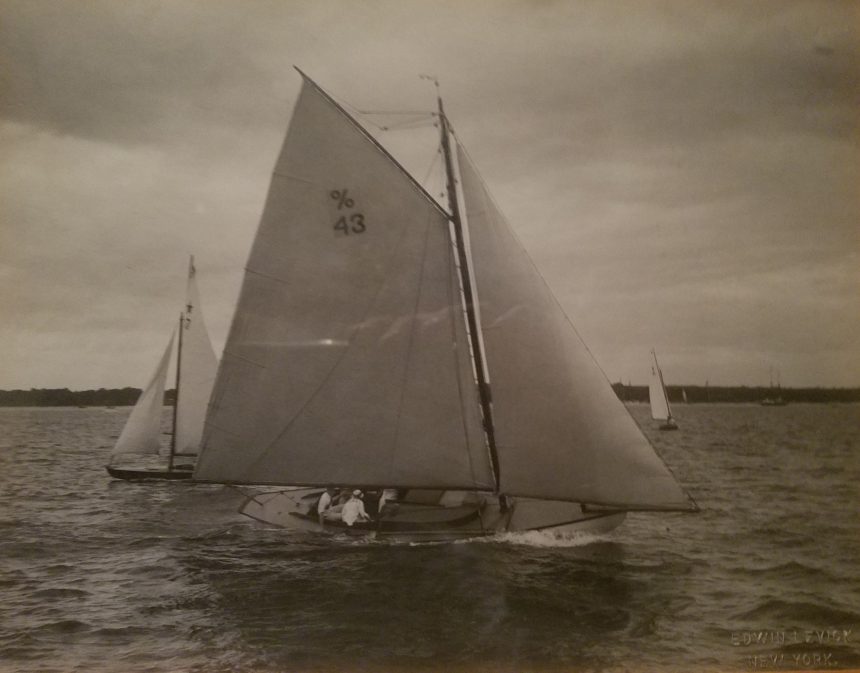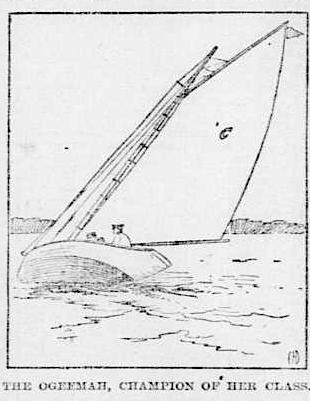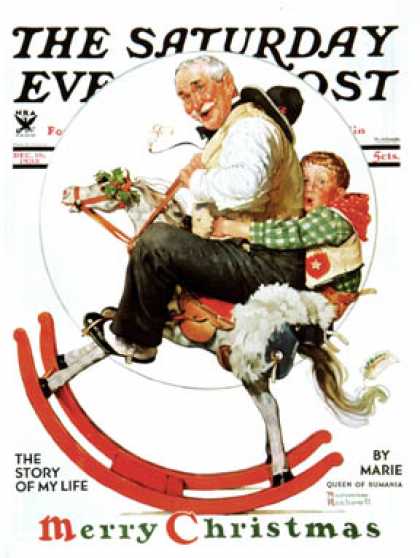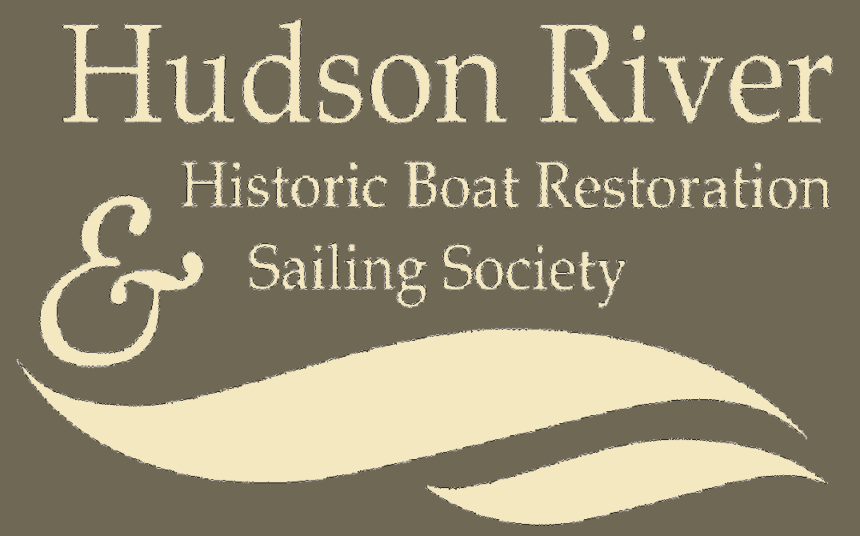
George Dealy, a HRHB member, recently sent us a photo of Ogeemah, his family’s sailboat, built in 1903, the same year as Eleanor, although he didn’t know that at the time. His great grandfather bought her and his grandfather and great uncle sailed her. George has a few trophy cups that she had won and some newspaper clippings. He couldn’t tell us much more.

Top Image — New Rochelle Yacht Club / Won by Ogeemah Sept. 10, 1915
Bottom Image — Handicap Yacht Racing Class Championship 4th Division won by Ogeemah, 1916
I knew there was a story here, and the librarian in me rose to the challenge to unearth and write it. No one needs to know how many research hours went into this project. In fact I finally gave up finding anything pertinent or interesting and started writing. My story was going to be that it was sad that so many of the old beautiful boats have been lost to history and how lucky we are to have the information about the Eleanor that we do have — atho it would be even better if we had more.
But life got in the way and and the story fell from my list of priorities. When it got be at the top of the list again, I started by searching one more time. “That’s how librarians are. They just can’t help it.” (The Boy who was Raised by Librarians, Barbara Morris.)
And there it was. The Library of Congress Chronicling America database led me to an article in, of all places, the Rock Island, Illinois paper, The Argus, May 19, 1906. Here is the article intact.
 Yachtsmen will be surprised to hear that Alfred Mackay of the Bensonhurst (N.Y.) Yacht club and the New York Canoe club has sold the champion Class Q racer Ogeemah to a member of the Larchmont (N.Y.) club and that the boat has left for its new home on Long Island sound.
Yachtsmen will be surprised to hear that Alfred Mackay of the Bensonhurst (N.Y.) Yacht club and the New York Canoe club has sold the champion Class Q racer Ogeemah to a member of the Larchmont (N.Y.) club and that the boat has left for its new home on Long Island sound.
The boat was designed by John R. Brophy, a well known naval architect and built in 1903 by R. Wallen & Sons. Her dimensions are 30 feet over all, 20 feet load water line, 7 feet 6 inches beam, 5 feet 2 inches draft; with a sail spread of 600 square feet.
The yacht was one of the first boats designed under the displacement rule.
During the first season she sailed at the top of Class P under the old water line length and sail area rule and won the championship of the class in the Gravesend Bay Yacht Racing association.
The boat no doubt will race in Class R, and it is believed by many well informed yachtsmen that there is not a boat of her measurement afloat that can beat her in any kind of weather other than a drifting match.
A. B. Clement was this new owner. His name was already familiar to me from articles on races in Long Island Sound that linked him to Ogeemah. He won quite a few.
John R. Brophy, “the amateur designer from Brooklyn” was chairman of the Atlantic Yacht club regatta committee and had “drawn lines for another in this class (R), and she is exceedingly attractive and should do well. Mr. Brophy designed the Ogeemah, the 22 footer which was the first boat built under the new rule of measurement, and the Ogeemah is still among the crackajacks.” But I found nothing more about him or R. Wallen.
The last of Ogeemah’s races captained by Clements which I discovered was mentioned in the New York Times in September 2012, and the first I discovered captained by “D. E. Dealy” was in May 2014.

That’s Gramps on the back! — 12/16/1933
According to George, his grandfather Arthur J. Dealy, Sr. “was born right around the turn of the 20th century to a fairly wealthy family in New Rochelle . . . He literally ran away from home to join the U.S. Navy during World War I. He served on a minesweeper in the North Atlantic.” The Dealy’s lived down the street from Norman Rockwell. As best as I can tell, he, and his older brother Ned (Edmund Dealy) were racing Ogeemah before that. The trophies indicate 1915 and 1916 when they would have been teenagers.
Thomas Helprin eventually bought and raced Ogeemah. The first entry I found in the Times mentioning Helprin is in 1924. She was a ferocious little racer and could outrun the larger boats, altho often with a handicap.
However she did have a few mishaps, such as this in Yawl Rissa Wins in Handicap Race:
The fresh southwest wind which greeted the starters caused two accidents and forced two entries to withdraw. T.F. Helprin’s Ogeemah suffered the most damage, her mast being carried away, and she had to be towed by The Walrus which had her halyards carried away in taking the turn around the D2 spar buoy which marked the second leg of the triangular journey of ten miles. — NY Times, 9/2/1928, p. 19.
And she sometimes came in last as in Pontiac Leads in a Mess of Winds. “A. J. Dealey” was the captain.
It was a rather difficult job for the craft of the Handicap Racing Class to pull off their eleventh annual race yesterday afternoon. They finally succeeded, but the light at Execution Rock was twinkling and all the yachts at anchor were showing their riding lights before the Ogeemah limped across the course close to 7 o’clcok last evening before the event became a part of the yachting history of the year. — NY Times, 9/10/1917, p. 17.
My last burst of research effort also solved the mystery of the significance of the name. What or was Ogeemah?
The St. Paul Globe Bookman’s Page published the Passing of Keenoosh-aw Ogeemah, a story by Martin Pollough-Pogue in the November 1901 edition of Outing. Keenoosh-aw Ogeemah is the name of a great shark in this story and perhaps the inspiration of the name of the boat. Ogeemah means King in Ojibway. The Ojibway lived in the Great Lakes area, mostly in Canada but also in the United States.
And where is she now? She seems to have vanished. Although she could be sailing somewhere under another name. I’m sure I will occasionally google her in the future to see what else I can find.
As Molly Harper, still another librarian, said in Nice Girls Don’t Have Fangs:
You can take the girl out of the library,
but you can’t take the neurotic, compulsively curious librarian out of the girl.
JAH
